For decades, Pothos plants have captivated houseplant enthusiasts with their stunning versatility and remarkable resilience. Imagine transforming a drab corner into a lush, vibrant haven with minimal effort—that’s the magic of a Pothos. These incredible plants are not just beautiful; they’re air purifiers, mood boosters, and a testament to nature’s enduring charm. Whether you’re a seasoned plant parent or just starting your green journey, our ultimate guide will unveil the secrets to cultivating the healthiest, most vibrant Pothos plants, exploring every unique variety, and empowering you with the knowledge to make them truly thrive. Get ready to turn your home into a Pothos paradise.
TABLE OF CONTENTS
Pothos: Why This Houseplant Reigns Supreme
The story of the Pothos (Epipremnum aureum), often affectionately called Devil’s Ivy, is one of surprising resilience and unparalleled charm. Originating from the Solomon Islands, these captivating Pothos plants earned their nickname for their almost impossible-to-kill nature, thriving even in challenging conditions where other plants might falter. Their rich history as adaptable, low-maintenance indoor greenery has cemented their status as a global favorite.
Pothos plants are celebrated for numerous reasons: their exceptional ease of care makes them perfect for beginners, while their air-purifying qualities contribute to a healthier home environment. Beyond their practical benefits, their cascading vines and diverse foliage patterns offer immense aesthetic appeal, making them ideal for hanging baskets, shelves, or climbing supports. This comprehensive guide covers everything from foundational care and detailed variety identification to propagation techniques, advanced problem-solving, and creative display ideas, ensuring your Pothos journey is nothing short of triumphant.
Essential Pothos Care: Nurturing Your Plant for Success
Cultivating healthy Pothos plants begins with understanding their fundamental needs. While incredibly forgiving, providing optimal conditions will unlock their full potential, leading to lush foliage and vigorous growth. Our focus here is on preventative measures, ensuring your Pothos thrives before problems even arise.
Pothos Care Checklist:
- Light: Bright, indirect sunlight.
- Watering: Allow topsoil to dry completely between waterings.
- Soil: Well-draining, aerated potting mix.
- Temperature: Consistent indoor temperatures (65-85°F / 18-29°C).
- Humidity: Average to high indoor humidity preferred.
- Fertilizing: Balanced liquid fertilizer during growing season.
- Pruning: Regularly to encourage bushiness.
Light Requirements: Finding the Perfect Spot
Light is paramount for the vitality of your Pothos plants. They flourish in bright, indirect light, which encourages vibrant variegation and robust growth. While they are famously tolerant of low-light conditions, prolonged exposure can lead to leggy growth and duller foliage, especially in variegated varieties. Conversely, direct, harsh sunlight can scorch their leaves, leaving unsightly brown patches. Observe your plant; leaves reaching for light or sparse growth indicate too little, while burnt tips suggest too much.
Watering Schedule: The Key to Happy Pothos
One of the most common pitfalls for new plant owners is improper watering. For Pothos plants, consistency and careful observation are key. The golden rule is to allow the top 1-2 inches of soil to dry out completely before watering again. Stick your finger into the soil; if it feels dry, it’s time to water. Overwatering can lead to dreaded root rot, characterized by yellowing leaves, soft stems, and a musty smell. Underwatering, on the other hand, will cause leaves to droop and eventually crisp. Always ensure your pot has drainage holes to prevent waterlogging.
| Pot Size (Diameter) | Environmental Factors | Watering Frequency (Approx.) | Signs of Overwatering | Signs of Underwatering |
|---|---|---|---|---|
| 4-6 inches | Warm, Dry Air / High Light | 5-7 days | Yellow leaves, mushy stems | Drooping, crispy leaves |
| 8-10 inches | Average Conditions | 7-10 days | Yellow leaves, mushy stems | Drooping, crispy leaves |
| 12+ inches | Cool, Humid Air / Low Light | 10-14+ days | Yellow leaves, mushy stems | Drooping, crispy leaves |
Soil & Potting: Creating the Ideal Environment
The right soil and pot are fundamental for healthy root development in your Pothos plants. They thrive in a well-draining, aerated potting mix that retains some moisture but never becomes waterlogged. A standard indoor potting mix amended with perlite, orchid bark, or coco coir works wonders. Aim for a slightly acidic to neutral pH (6.0-7.0). When selecting a pot, ensure it has ample drainage holes to prevent root rot. Repot Pothos every 1-2 years, or when you notice roots circling the pot or growing out of the drainage holes, always choosing a pot only slightly larger than the previous one.
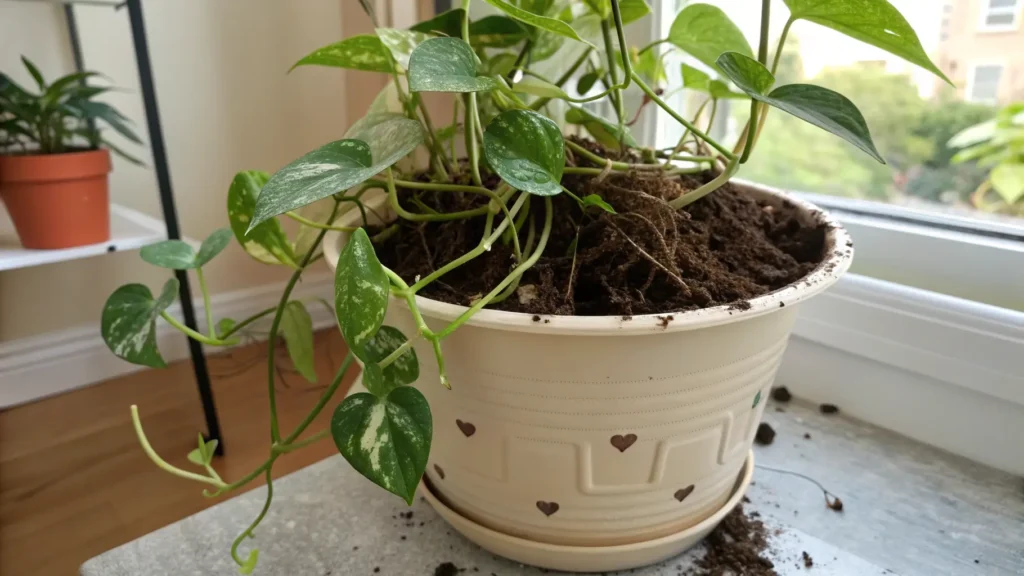
Temperature & Humidity: Environmental Sweet Spots
Pothos plants are quite adaptable to typical indoor temperatures, ideally thriving between 65-85°F (18-29°C). They are not frost-tolerant, so protect them from cold drafts and sudden temperature drops. While average household humidity is usually sufficient, Pothos appreciate higher humidity levels, especially during dry winter months or in arid climates. Increased humidity promotes larger leaves and more vigorous growth.
Budget-Friendly Humidity Tips:
- Pebble Trays: Place your pot on a tray filled with pebbles and water, ensuring the pot itself isn’t sitting directly in the water.
- Grouping Plants: Grouping several plants together naturally increases local humidity through transpiration.
- Misting: Lightly misting the leaves a few times a week can provide a temporary humidity boost (ensure good air circulation to prevent fungal issues).
- Location: Placing your Pothos in a naturally more humid room, like a bathroom or kitchen, can also be beneficial.
Fertilizing Your Pothos: Fueling Growth
Feeding your Pothos plants correctly can significantly boost their growth and vibrance. Fertilize only during the active growing season (spring and summer), typically once a month or every other month. Use a balanced liquid houseplant fertilizer, diluted to half strength to prevent nutrient burn. During fall and winter, when growth naturally slows, cease fertilizing. Over-fertilization can lead to crispy leaf edges, stunted growth, and even root damage.
For beginners, brands like “Miracle-Gro Indoor Plant Food” or “Schultz Liquid Plant Food” are readily available and simple to use. Remember, more isn’t always better; consistently under-fertilizing is far less harmful than over-fertilizing. If you notice signs of stress after fertilizing, flush the soil thoroughly with plain water.
Pruning & Training: For Bushiness and Shape
Pruning is vital for maintaining the shape, size, and bushiness of your Pothos plants. Without it, they can become leggy and sparse, with long vines and fewer leaves near the base. Pruning encourages the plant to branch out, resulting in a fuller appearance. To prune, use clean, sharp shears to cut just below a leaf node (the bump on the stem where a leaf or root grows). You can also train Pothos to climb by providing a moss pole, trellis, or even running their vines along a wall, using clips or ties to secure them. Aerial roots will often cling to these supports, aiding in the plant’s stability and allowing for larger leaves to develop.
Explore Popular Pothos Varieties: Identification & Care Nuances
While all Pothos plants are generally easy to care for, the diversity within the Epipremnum aureum and Epipremnum pinnatum families is truly astonishing. Each variety boasts unique leaf shapes, sizes, and mesmerizing variegation patterns that respond differently to light. This section serves as your definitive visual guide, helping you identify and understand the subtle care considerations for some of the most popular and sought-after Pothos types. Our stunning, distinct, and professionally photographed images will guide you through this vibrant world.
Golden Pothos (Epipremnum aureum ‘Golden’)

The undisputed classic, the Golden Pothos is perhaps the most recognized and beloved of all Pothos plants. Its heart-shaped, medium-green leaves are generously flecked with splashes of golden-yellow variegation, varying in intensity based on light exposure. This variety is renowned for its hardiness and adaptability, making it the ultimate beginner-friendly houseplant. It tolerates a wide range of conditions and grows vigorously, cascading beautifully from hanging baskets.
Care Snapshot for Golden Pothos: It’s exceptionally forgiving, but bright indirect light will enhance its golden variegation. Too little light will result in greener, less variegated leaves.
Marble Queen Pothos (Epipremnum aureum ‘Marble Queen’)
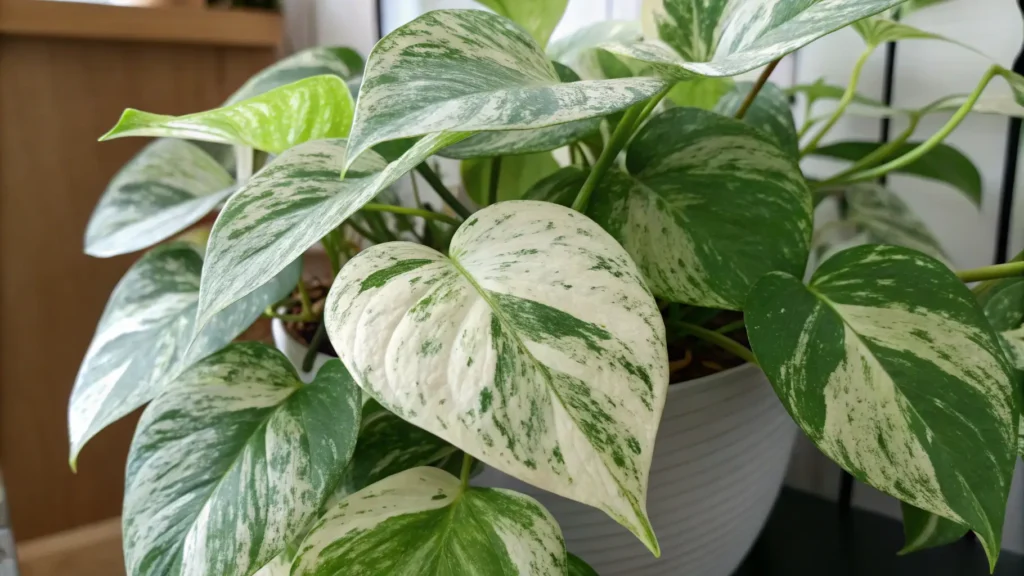
The Marble Queen Pothos is a showstopper, cherished for its intricate creamy-white and dark-green marbling. Each leaf is a unique work of art, with the white variegation often dominating. This striking pattern makes it a highly desirable addition to any collection. The Marble Queen tends to grow a bit slower and can be slightly more demanding than its Golden counterpart due to its higher white variegation.
Care Nuances for Marble Queen Pothos: To maintain its stunning marbling, provide consistent bright, indirect light. Insufficient light can cause the white areas to fade, leading to a greener appearance. Protect it from direct sun, which can scorch its delicate white patches.
Neon Pothos (Epipremnum aureum ‘Neon’)
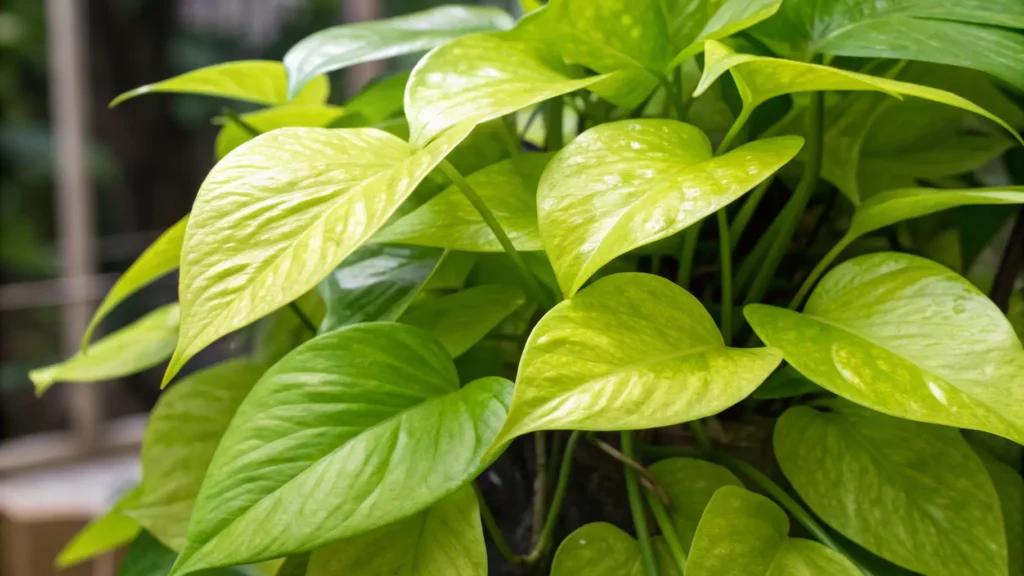
As its name suggests, the Neon Pothos is known for its incredibly vibrant, almost fluorescent lime-green or chartreuse leaves. This variety lacks the typical variegation of other Pothos but makes up for it with its electrifying color that brightens any space. Its distinct hue makes it a popular choice for adding a pop of color to a plant collection.
Care Nuances for Neon Pothos: The intensity of its neon color is directly influenced by light. Brighter indirect light will keep its color vivid and brilliant, while lower light conditions can cause the leaves to darken to a deeper green.
N’Joy Pothos (Epipremnum aureum ‘N’Joy’)
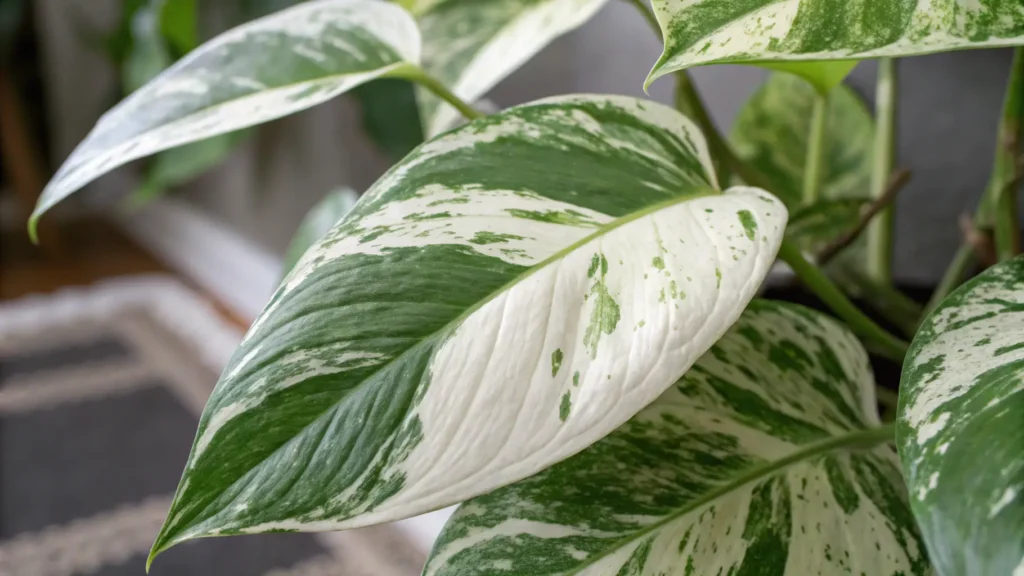
The N’Joy Pothos is a delightful, compact variety with smaller, slightly crinkled leaves. Its defining characteristic is the stark, crisp white variegation that typically appears around the edges of the deep green leaves, creating a clean, defined pattern. It’s often confused with other variegated Pothos plants like Manjula or Global Green.
Visual Comparison (N’Joy vs. Manjula vs. Global Green):
- N’Joy: Crisp, distinct white margins, often no green specks within the white. Smaller leaves.
- Manjula: Broader, wavier leaves, a mix of white, cream, and silver-green splotches, often bleeding into the green areas.
- Global Green: Distinctive dark green margins with a lighter, lime-green inner variegation.
Manjula Pothos (Epipremnum aureum ‘Manjula’)

The Manjula Pothos is a highly sought-after variety, known for its broad, somewhat wavy leaves and its extensive, highly varied variegation. It features splashes of white, cream, and silver-green that marble across the deep green foliage, often extending into the green areas in unique patterns. No two leaves are exactly alike, making each plant a living piece of art.
Care Nuances for Manjula Pothos: Like the Marble Queen, the Manjula’s stunning variegation requires bright, indirect light to flourish. Its slower growth rate and higher white areas make it a bit more sensitive to both overwatering and direct sun exposure.
Cebu Blue Pothos (Epipremnum pinnatum ‘Cebu Blue’)

A distinctly different kind of Pothos, the Cebu Blue (Epipremnum pinnatum) is prized for its elongated, silvery-blue-green leaves that develop a unique fenestrated (split) appearance as they mature and climb. Unlike the aureum varieties, it has a more textured, almost leathery feel to its leaves and grows as a shingler in its natural habitat. Its juvenile leaves are whole, but mature ones can develop stunning splits reminiscent of Monsteras.
Care Nuances for Cebu Blue Pothos: While still easy care, the Cebu Blue appreciates slightly higher humidity and benefits greatly from a moss pole or support to encourage larger, more mature leaves and its characteristic shingling growth.
Other Notable Pothos Varieties (Jade, Global Green, Jessenia, etc.)
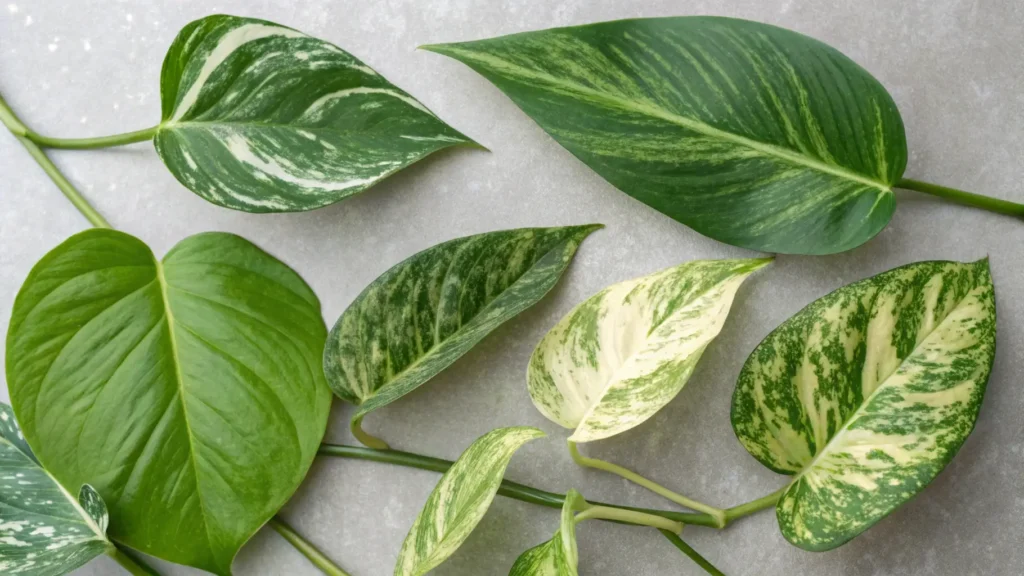
Beyond these popular types, the world of Pothos plants continues to expand with new and exciting varieties.
- Jade Pothos: The simplest Pothos, featuring solid, glossy, deep green leaves with no variegation. Extremely hardy and tolerant of lower light.
- Global Green Pothos: Characterized by dark green margins and a lighter, lime-green inner variegation, offering a beautiful, subtle contrast.
- Jessenia Pothos: Similar to Marble Queen but with lighter, more muted lime-green and yellow variegation, often described as a “less intense” Marble Queen.
- Glacier Pothos: A smaller variety with prominent white and silver-gray variegation, often concentrated near the leaf margins, giving it a cool, icy appearance.
- Hawaiian Pothos: A large-leafed cultivar of Golden Pothos, boasting impressive leaf size and bold golden variegation when mature.
Each of these Pothos types offers a unique aesthetic and can add incredible diversity to your indoor jungle.
Pothos Propagation: Grow Your Collection (Step-by-Step)
One of the most rewarding aspects of owning Pothos plants is their incredible ease of propagation. You can easily create new plants from cuttings, sharing them with friends or expanding your own collection. This process is simple, cost-effective, and a fantastic way to ensure the legacy of your favorite Pothos lives on.
Step-by-Step Water Propagation Method:
- Select a Healthy Stem: Choose a healthy vine at least 4-6 inches long with 2-3 leaves and a few nodes (the small bumps on the stem where leaves and roots emerge).
- Make Your Cut: Using clean, sharp scissors or pruners, cut the stem just below a node. Remove any leaves that would be submerged in water.
- Place in Water: Put the cutting in a clear glass or jar filled with fresh, room-temperature water. Ensure at least one node is submerged.
- Find a Spot: Place the jar in a location with bright, indirect light.
- Change Water Regularly: Replace the water every few days to prevent bacterial growth.
- Wait for Roots: Roots should start to appear within 1-3 weeks. Once the roots are 1-2 inches long, your new Pothos plant is ready for potting.
Step-by-Step Soil Propagation Method:
- Prepare Cuttings: Follow steps 1 and 2 from the water propagation method.
- Optional Rooting Hormone: Dip the cut end of the stem in rooting hormone powder to encourage faster root development (optional but recommended).
- Plant in Soil: Plant the cutting directly into a small pot filled with well-draining potting mix. Bury at least one node in the soil.
- Water Gently: Water thoroughly until water drains from the bottom.
- Create Humidity (Optional): Cover the pot with a clear plastic bag or dome to create a mini-greenhouse effect, increasing humidity and aiding rooting.
- Maintain Moisture & Light: Keep the soil consistently moist (but not soggy) and place the pot in bright, indirect light. Roots will typically form in 3-6 weeks. You can gently tug on the cutting; if it resists, roots have formed.
Troubleshooting & Problem Solving for Your Pothos
Even the most resilient Pothos plants can occasionally face challenges. Recognizing the signs of distress early and understanding their causes is key to a quick recovery. This section provides a systematic approach to diagnosing and resolving common issues, helping you maintain a healthy and vibrant plant.
Common Leaf Problems (Yellow, Brown, Drooping, Leggy)
Understanding what your Pothos leaves are telling you is crucial for successful care.
- Yellow Leaves:
- Cause: Most often, overwatering or poor drainage. Root rot can also cause yellowing. Less commonly, nutrient deficiency.
- Solution: Allow the soil to dry out more thoroughly between waterings. Check drainage holes. If root rot is suspected, repot into fresh, dry soil after trimming any mushy roots.
- Brown Tips/Edges:
- Cause: Typically, low humidity, underwatering, or sometimes too much direct sunlight. Mineral buildup from tap water can also contribute.
- Solution: Increase humidity around the plant (pebble tray, humidifier). Adjust watering schedule to water more consistently. Move to a less sunny spot. Use distilled or filtered water.
- Drooping Leaves:
- Cause: The most common cause is underwatering the plant is thirsty! However, surprisingly, severe overwatering and root rot can also cause drooping as roots can’t absorb water.
- Solution: Check soil moisture. If dry, water thoroughly. If wet, let it dry out completely. If root rot is suspected, inspect roots.
- Leggy Growth (Long Stems, Sparse Leaves):
- Cause: Insufficient light. The plant is stretching to find more light, resulting in long, bare stems.
- Solution: Move your Pothos to a brighter location with indirect light. Prune back the leggy vines to encourage bushier growth (you can propagate the cuttings!).
Pests and Diseases: Identification & Treatment
While generally hardy, Pothos plants can occasionally fall victim to common houseplant pests or fungal issues. Early detection is your best defense.
Pest Control Cheat Sheet:
- Spider Mites: Tiny red or brown mites, often visible as fine webbing on leaves.
- Treatment: Isolate the plant. Spray thoroughly with insecticidal soap or neem oil, ensuring coverage of undersides of leaves. Repeat every 5-7 days for several weeks.
- Mealybugs: Small, white, cotton-like clusters, typically in leaf axils or on stems.
- Treatment: Dab with a cotton swab dipped in rubbing alcohol to remove individual pests. Then spray with insecticidal soap or neem oil.
- Thrips: Tiny, slender insects that cause silvery streaks and distorted new growth.
- Treatment: Systemic insecticide or repeated applications of neem oil/insecticidal soap. Remove affected leaves.
- Fungus Gnats: Small, black flies buzzing around the soil, indicating overly moist conditions.
- Treatment: Allow soil to dry out completely between waterings. Use sticky traps for adults. Apply beneficial nematodes or BTI (Bacillus thuringiensis israelensis) to the soil.
- General Prevention: Inspect new plants, maintain good air circulation, and avoid overwatering. For fungal issues, ensure good drainage and airflow.
Advanced Pothos Care & Creative Display Ideas
Beyond basic care, there’s a whole world of possibilities to explore with your Pothos plants. From encouraging mature growth to showcasing their beauty in unique ways, these tips will elevate your Pothos game and impress any plant enthusiast.
- Supporting Aerial Roots: In their natural habitat, Pothos climb trees, using aerial roots to cling and absorb moisture. Indoors, providing a moss pole or wooden plank for climbing can mimic this, encouraging the plant to produce larger, more mature leaves that may even develop fenestrations (splits) in some varieties (like Cebu Blue Pothos).
- Winter Care: During colder months, Pothos growth slows. Reduce watering frequency, ensure they are away from cold drafts, and maintain consistent, ambient temperatures. Avoid fertilizing until spring.
- Benefits of Climbing: Allowing Pothos to climb not only promotes larger foliage but also makes the plant appear fuller and more impressive, utilizing vertical space in your home.
Creative Pothos Display Ideas:
- Kokedama: Create beautiful moss balls (kokedama) with small Pothos plants, perfect for hanging or tabletop displays.
- Wall Hangings: Train Pothos vines to grow creatively along walls, using clear adhesive clips to create intricate living art.
- Terrariums & Paludariums: Pothos thrive in high-humidity environments, making them excellent candidates for enclosed terrariums or even paludariums (terrariums with both land and water features).
- Moss Poles & Trellises: Utilize moss poles or decorative trellises to encourage upward growth and showcase the plant’s climbing nature.
- Macrame Hangers: Classic and elegant, macrame hangers elevate Pothos plants, allowing their vines to cascade freely.
Pothos Toxicity: What You Need to Know
While beautiful and easy to care for, it’s crucial to be aware that Pothos plants are toxic if ingested by humans or pets. This toxicity is due to insoluble calcium oxalates, needle-shaped crystals present in the plant’s leaves and stems. When chewed, these crystals can cause immediate irritation.
- Symptoms in Pets: In dogs and cats, ingestion can lead to oral irritation, pain and swelling of the mouth, tongue, and lips, excessive drooling, vomiting, and difficulty swallowing. In severe cases, swelling can obstruct the airway.
- Symptoms in Humans: Similar symptoms can occur in humans, including burning and irritation of the mouth and throat, nausea, and vomiting. Skin contact with the sap can also cause mild irritation.
- Precautions: Always place Pothos plants out of reach of curious children and pets. Consider hanging baskets or shelves that are inaccessible. Teach children not to put plant parts in their mouths. Always wash hands after handling Pothos, especially when pruning.
“While Pothos plants are incredibly common and generally safe in homes with careful placement, pet owners should be particularly vigilant,” advises Dr. Sarah Miller, DVM, a veterinary toxicology specialist. “The calcium oxalate crystals can cause significant discomfort, so immediate veterinary attention is recommended if ingestion is suspected, even if symptoms seem mild.”
Frequently Asked Questions (FAQ) About Pothos
Is Pothos easy to care for?
Yes, Pothos plants are widely considered one of the easiest houseplants to care for, making them perfect for beginners. They tolerate a range of conditions and are forgiving of occasional neglect.
How fast does Pothos grow?
Pothos plants are fast-growing, especially during the spring and summer. With optimal conditions (bright indirect light, regular watering, and occasional fertilizer), vines can grow several feet in a single growing season.
Can Pothos live in water forever?
While Pothos cuttings can thrive in water for extended periods, they are not designed to live in water indefinitely. For long-term health and mature growth, it’s best to eventually transfer water-propagated Pothos plants to soil once their roots have developed.
What is the difference between Pothos and Philodendron?
Pothos (Epipremnum aureum) and Heartleaf Philodendron (Philodendron hederaceum) are often confused due to similar appearances. Key differences include: Pothos leaves are typically thicker and waxier, with a groove along the petiole (leaf stem), and their new leaves unfurl directly from the stem. Philodendron leaves are generally thinner, have a rounder petiole, and new leaves emerge from a cataphyl (a papery sheath).
Where is the best place to buy Pothos plants?
Pothos plants are widely available. You can find them at local nurseries, garden centers, big-box stores (like Home Depot or Lowe’s), and reputable online plant retailers. Look for healthy plants with vibrant foliage and no signs of pests or disease.
Conclusion: Your Thriving Pothos Journey Awaits
From their effortless elegance to their remarkable resilience, Pothos plants truly are a houseplant superstar. This ultimate guide has equipped you with everything needed to nurture, identify, and creatively display these incredible plants, transforming them from simple greenery into thriving botanical masterpieces. By understanding their light, water, and soil needs, exploring their diverse varieties, mastering propagation, and confidently troubleshooting any issues, you’re now ready to embark on a successful and rewarding Pothos journey. We encourage you to embrace the joy of growing, experimenting with different displays, and perhaps even sharing your new plant babies. The world of Pothos is vibrant and welcoming, and with this knowledge, your Pothos plants will flourish, bringing enduring beauty and a touch of the tropics to your home. Share your own thriving Pothos stories and photos with us on social media we’d love to see your success!
